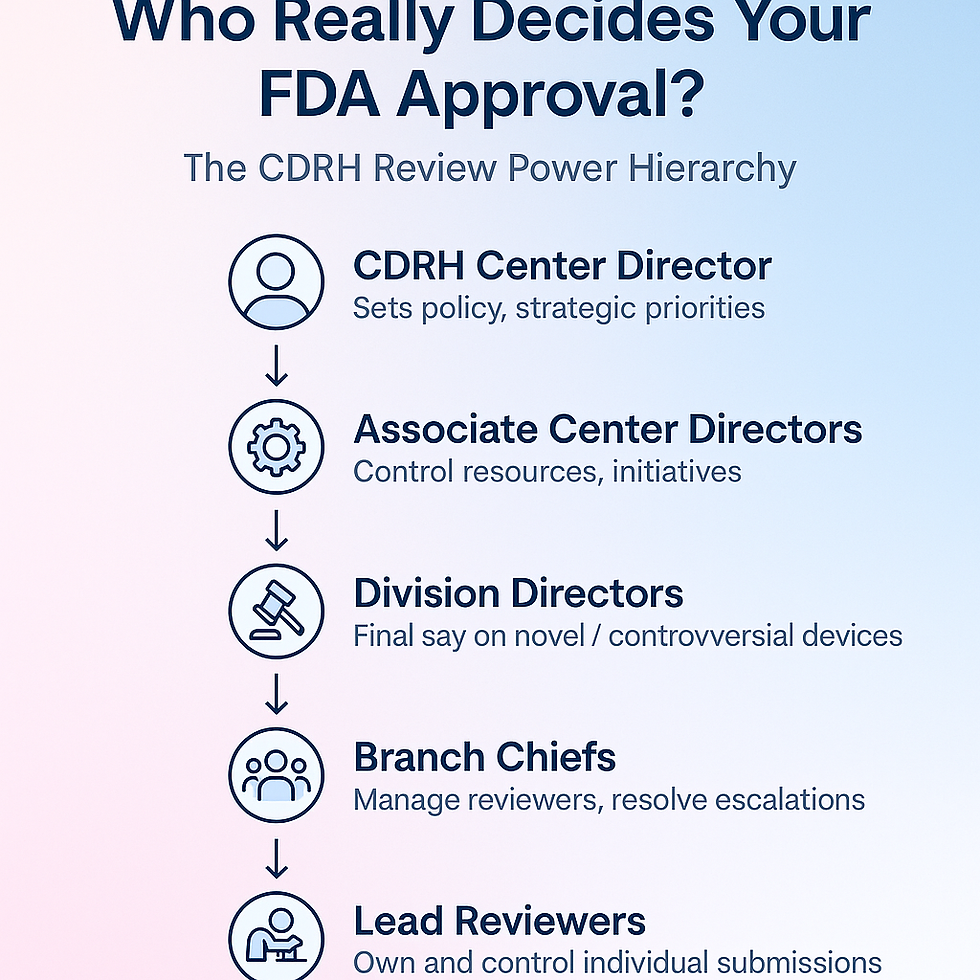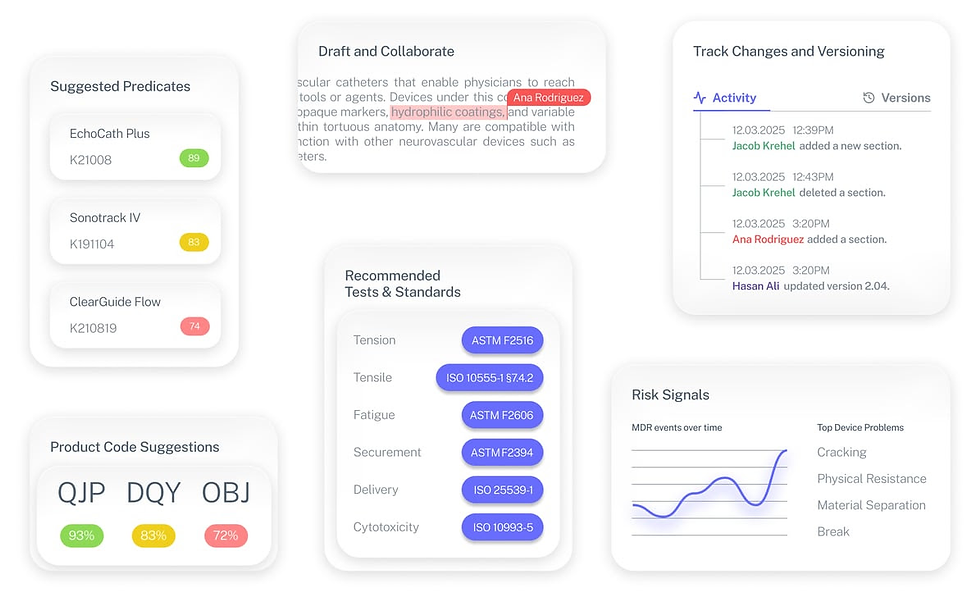FDA Complete Guide: Everything Medical Device Companies Need to Know 2025
- Beng Ee Lim

- Jul 28
- 8 min read
Updated: Sep 7
The FDA’s Center for Devices and Radiological Health (CDRH) regulates medical devices in the United States. Devices reach the market via 510(k) clearance, De Novo classification, or PMA approval, depending on risk and predicate status. Under MDUFA V, FDA’s review goals include 510(k) decisions within 90 FDA days, De Novo within 150 FDA days, and PMA average total time to decision of 285–290 days. Companies that understand FDA's decision-making process, build early relationships with reviewers, and leverage competitive intelligence from FDA databases cut approval times and avoid costly submission mistakes.
This guide reveals how smart companies turn FDA requirements from compliance burdens into competitive weapons.

Why FDA Mastery = Business Success
FDA approved more than 100 novel devices in 2018, a fourfold increase over 2009, yet most companies still treat regulatory strategy as an afterthought. Here's the brutal reality:
The $10 Million Mistake: Poor FDA strategy costs the average medtech startup $2-10 million in preventable delays, failed submissions, and redesign costs.
The Speed Advantage: Companies using expedited FDA pathways like Breakthrough Device Designation get products to market 1-2 years faster than competitors following standard routes.
The Intelligence Gap: Majority of companies manually search FDA databases when intelligent platforms could reveal competitive insights in minutes.
What This Costs You
Wrong Pathway Selection: Choosing PMA over 510(k) unnecessarily = $5-15 million extra in clinical trials
Poor Predicate Selection: Weak 510(k) predicate = 6-12 month review delays
Quality System Failures: FDA 483 observations = $500K-$2M in remediation costs
Late FDA Engagement: No pre-submission meetings = 40% higher chance of additional information requests
Smart companies flip this equation: They use FDA requirements to accelerate development, block competitors, and build market advantages.
The Power Structure: Who Really Controls Your Approval
Understanding FDA's decision-making hierarchy determines whether you get fast-track treatment or regulatory purgatory.
The CDRH Command Structure
Center Director: Sets policy priorities - currently focused on AI/digital health, cybersecurity, and real-world evidence
Associate Center Directors: Control budget allocation and strategic initiatives
Division Directors: Make actual approval decisions for your device type
The 8 Device Kingdoms
CDRH's Office of Health Technologies divides into 8 specialized divisions that operate like separate fiefdoms:
OHT 1 Ophthalmic, Anesthesia, Resp/ENT, Dental
OHT 2 Cardiovascular
OHT 3 Reproductive, Gastro-Renal, Urological, General Hospital Device and Human Factors
OHT 4 Surgical & Infection Control
OHT 5 Neurological & Physical-Medicine
OHT 6 Orthopedic
OHT 7 In Vitro Diagnostics
OHT 8 Radiological Health
Strategic Intelligence: Each division has different personalities, priorities, and approval patterns. Knowing your division's quirks = faster approvals.
The Real Decision Makers
Lead Reviewers: The individual scientist who controls your submission's fate
Branch Chiefs: Escalation point for complex decisions
Division Directors: Final authority on novel or controversial devices
Relationship Reality: Companies with established relationships get more constructive feedback and faster resolution of issues. This isn't about gaming the system—it's about building trust through competence and transparency.

The Three Pathways That Determine Your Fate
Every device follows one of three routes to market. Choose wrong, and you'll waste years and millions.
510(k): The Volume Game
The Numbers: Annual 510(k) clearances range from 2,804 to 5,762 (median 3,404)
Success Rate: ~95% get substantial equivalence
Hidden Cost: $50K-$500K total cost including testing and consulting
Timeline Reality: 90-day FDA goal, 4-8 months actual average
When It Works: Clear predicate exists, technology is incremental improvement
When It Fails: Novel technology, no appropriate predicate, safety questions
Strategic Advantage: Use FDA's 510(k) database to find "predicate chains" - sequences of devices that establish regulatory precedent for increasingly sophisticated technology.
PMA: The Clinical Gauntlet
The Numbers: Annual PMA approvals range from 8 to 56 (median 32)
Success Rate: ~78-85 % approval rate after cycles.
Real Cost: $5-50+ million including clinical trials
Timeline Reality: 18+ months from submission to approval
When It's Required: Class III devices, life-sustaining/supporting devices, novel high-risk technology
Strategic Edge: Companies conducting adaptive clinical trials and leveraging real-world evidence get FDA approval 20-30% faster
De Novo: The Innovation Pathway
The Opportunity: Become the predicate device for entire new categories
Timeline: 150 days for FDA decision
Strategic Value: De Novo devices create new markets and establish competitive moats
When to Use: No predicate exists, automatic Class III designation inappropriate, breakthrough technology
The Hidden Costs of FDA Compliance
Most companies budget for user fees and miss the real costs:
User Fees (The Visible Costs)
FY 2025 Rates:
510(k): $24,335 (standard), $6,084 (small business)
PMA: $540,783 (standard), $135,196 (small business)
De Novo: $162,235 (standard), $40,559 (small business)
User-fee revenue has surged 8-fold since 2003, covering nearly one-third of FY 2019 review costs (and 43 % in 2020).
The Real Costs (The Invisible Killers)
Quality System Implementation: $200K-$2M for robust QSR compliance
Clinical Trials: $1-20M depending on study design and endpoints
Regulatory Consulting: $150K-$1M for complex submissions
Opportunity Cost: 6-18 months delayed market entry = $5-50M in lost revenue
The 2026 Bomb: Quality Management System Regulation (QMSR) takes effect February 2, 2026, requiring transition from current QSR to ISO 13485:2016 alignment. Companies starting transition now avoid last-minute compliance chaos.
2025 Game Changers: What's Different Now
The regulatory landscape shifted dramatically in 2025. Companies adapting fastest gain massive advantages.
AI Revolution and Regulatory Reality
The New Rules: FDA's AI draft guidance was first released in 2025, requiring clear documentation of algorithmic decision-making processes and continuous monitoring mechanisms.
Strategic Opportunity: AI-enabled devices get expedited review under breakthrough device designation, but only with robust validation data.
The Compliance Trap: Most AI companies underestimate FDA's software validation requirements. Build validation frameworks early or face 12+ month delays.
Cybersecurity: From Afterthought to Approval Blocker
New Reality: Medical device cybersecurity failures cost healthcare systems billions. FDA now requires:
Threat modeling throughout device lifecycle
Software Bill of Materials (SBOM)
Vulnerability management and incident response plans
Business Impact: Devices without cybersecurity documentation face automatic additional information requests, pushing decisions months past the 112-day target.
Real-World Evidence: The Data Advantage
FDA Priority: FDA is doubling down on NESTcc’s collaborative community—now tapping 220 M+ patient records—to weave high-quality real-world data into device submissions.
Strategic Value: Companies generating high-quality real-world data get faster approvals for label expansions and new indications.
The Competitive Intelligence Weapon
Smart companies don't just comply with FDA—they use FDA data to dominate competitors.
Database Mining for Market Domination
510(k) Intelligence: Track competitor approval patterns, identify market gaps, benchmark claims
PMA Analysis: Reverse-engineer successful clinical study designs, understand FDA expectations
MAUDE Monitoring: Identify competitor safety issues, benchmark your performance, spot market opportunities
Early Warning Systems
FDA Guidance Pipeline: Monitor draft guidance for advance warning of requirement changes
Advisory Panel Tracking: Follow device advisory committee meetings for regulatory trend signals
Enforcement Intelligence: Track FDA warning letters and 483 observations to avoid compliance pitfalls
Strategic Mistakes That Kill Companies
Learn from others' failures to avoid repeating expensive mistakes.
The $15 Million Predicate Mistake
Case Study: Startup selected weak predicate device for 510(k) submission. FDA issued Not Substantially Equivalent letter. Company had to conduct $15M clinical trial for PMA pathway instead.
Lesson: Invest $50K in predicate research to avoid $15M clinical trial.
The Quality System Death Spiral
Pattern: Company receives FDA 483 observations during pre-approval inspection. Approval delayed 12+ months while addressing quality system deficiencies.
Prevention: Implement robust quality systems early. FDA inspection readiness = faster approvals.
The Late Engagement Penalty
Reality: Companies waiting until submission to engage FDA face 40% higher rates of additional information requests
Solution: Pre-submission meetings save months and improve approval odds.
Working the System (Legally and Ethically)
Understanding FDA's human dynamics accelerates your path to approval.
The Relationship Factor
FDA Reality: Reviewers prefer working with competent, responsive companies
Strategic Approach: Build reputation through thorough submissions, prompt responses, and collaborative problem-solving
Long-term Value: Companies with good FDA relationships get benefit of doubt on borderline decisions
Communication Optimization
What Works: Clear questions, organized data, specific asks, proposed solutions
What Fails: Vague requests, incomplete information, adversarial tone, last-minute surprises
Meeting Strategy
Pre-submission Meetings: Essential for complex devices, novel technology, or unclear regulatory pathways
Advisory Panel Prep: For PMA devices, panel preparation determines approval success
Submission Issue Request (SIR): Use for general feedback on development programs
Decision Frameworks for Smart Companies
Turn this intelligence into action with clear decision criteria.
Pathway Selection Matrix
Choose 510(k) when:
Clear, strong predicate exists
Technology is incremental improvement
Safety profile similar to existing devices
Choose PMA when:
No appropriate predicate
Novel mechanism of action
High-risk life-sustaining device
Choose De Novo when:
Novel technology with moderate risk
Opportunity to create new device category
No predicate exists but PMA seems excessive
Timing Strategy
Early Stage: Focus on classification and pathway strategy
Development Phase: Engage FDA through pre-submission meetings
Pre-submission: Conduct competitive intelligence and predicate analysis
Post-submission: Maintain responsive communication and relationship building
Your Next Steps: Turn Intelligence into Advantage
Understanding FDA is worthless without strategic application. Here's how to convert this knowledge into competitive advantage:
Immediate Actions (This Week):
Classify your device and understand your regulatory pathway
Research competitors using FDA databases for intelligence gathering
Identify your FDA division and understand their specific priorities
Schedule pre-submission meeting if developing novel technology
Strategic Initiatives (Next 90 Days):
Build quality systems aligned with 2026 QMSR requirements
Develop FDA relationship strategy through industry conferences and meetings
Create competitive monitoring system for ongoing market intelligence
Plan clinical development if PMA pathway likely
Long-term Competitive Positioning:
Regulatory expertise as core competency, not outsourced function
FDA database intelligence integrated into business development strategy
Early engagement culture with regulatory authorities globally
Quality systems excellence preventing compliance surprises
The companies dominating medtech aren't just building better devices—they're building better regulatory strategies. In a heavily regulated industry, regulatory intelligence is competitive intelligence.
Ready to turn FDA requirements into competitive weapons? Master the specific pathways with our detailed guides on 510(k) strategy, PMA development, and regulatory database intelligence.
The Fastest Path to Market
No more guesswork. Move from research to a defendable FDA strategy, faster. Backed by FDA sources. Teams report 12 hours saved weekly.
FDA Product Code Finder, find your code in minutes.
510(k) Predicate Intelligence, see likely predicates with 510(k) links.
Risk and Recalls, scan MAUDE and recall patterns.
FDA Tests and Standards, map required tests from your code.
Regulatory Strategy Workspace, pull it into a defendable plan.
👉 Start free at complizen.ai

Frequently Asked Questions
What's the single biggest FDA mistake companies make?
Waiting too long to engage FDA. Companies with early FDA interaction get approvals 30-40% faster than those waiting until submission. Pre-submission meetings prevent costly mistakes and build relationships.
How much should I budget for FDA approval?
510(k) total costs: $100K-$750K including user fees, testing, consulting, and regulatory preparation. PMA total costs: $5M-$50M+ including clinical trials and multi-year development. Budget 2-3x initial estimates for contingencies.
Can small companies compete with big pharma at FDA?
Yes, with smart strategy. Small companies often get faster FDA attention because they're more responsive and focused. FDA's expedited programs like Breakthrough Device Designation specifically help innovative small companies.
How do I know if my device needs clinical trials?
Most 510(k) devices don't require clinical data - substantial equivalence can be demonstrated through bench testing. All Class III PMA devices require clinical trials. Some Class II devices need clinical data when technological differences raise safety/effectiveness questions.
What happens if FDA says no?
FDA rarely outright rejects devices. They typically request additional information or suggest alternative pathways. 95% of 510(k) submissions eventually receive clearance after addressing FDA concerns.
How important are FDA relationships really?
Critical for complex submissions. While FDA maintains objective standards, companies with established relationships get more constructive feedback, faster responses to questions, and collaborative problem-solving approaches.
Should I hire FDA consultants?
For complex devices, absolutely. Former FDA reviewers understand agency thinking and can accelerate approvals. Budget $150K-$500K for expert regulatory consulting on novel or high-risk devices.
What's changing in 2025 that affects my strategy?
Three major shifts: AI/software validation requirements tightening, cybersecurity becoming approval factor, and real-world evidence increasingly accepted for regulatory decisions. Companies adapting early gain competitive advantages.



